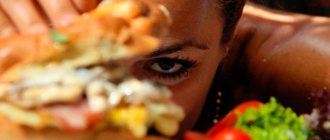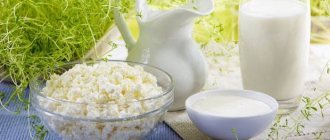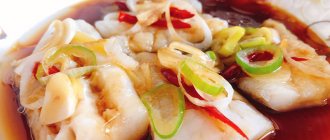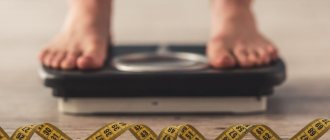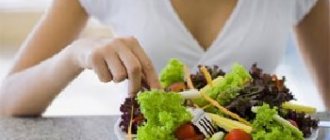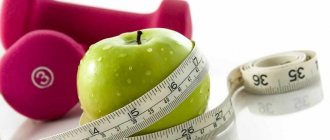The Dukan diet is quite well known all over the world and is loved not only by film and television stars, but also by ordinary citizens.
This simple nutritional method, the goal of which is to lose weight, is designed in 4 successive stages. Two of them work directly on the goal of the diet, that is, on losing extra pounds, and the final two work to consolidate and maintain the result.
If with the first phase of the diet, “Attack,” everything is very clear, then with the second, “Alternation” or “Cruise,” everything is not so clear. Let's look at this issue in more detail in the article.
What is the “alternation” phase?
Unlike the initial stage of the diet, where the emphasis is only on eating foods that contain the maximum amount of proteins, the second phase involves alternating meals with proteins and vegetables. This is where the name “Alternation” (or “Cruise”) comes from.
This stage includes two interconnected sequential cycles - the circle of pure proteins (PB) and the circle of protein-vegetables (VP). The last round requires the consumption of proteins supplemented with vegetables, no matter whether they are raw or cooked.
Features of the “alternation” stage
This phase has a number of features:
- Compared to the first phase of the Dukan “Attack” nutrition method, the “Alternation” stage is considered more relaxed due to the inclusion of vegetables in the diet.
- You can include vegetables in the menu according to the “one after another” scheme, that is, one day will be only protein, and the next day - protein and vegetables. If the weight is large, then it is possible to change the alternation to “five through five.”
- Having chosen the most suitable scheme, you should get the same number of days with pure protein and protein-vegetable days per month.
- There is no need to focus on increasing the black and white. This can only be done with BO days.
- The “Alternating” stage lasts until the desired number appears on the scales. On average, in this phase of the diet, weight loss occurs by 1-1.2 kg in 7 days.
- Whatever pattern of alternation of days is chosen, the result in the form of “lost” kilograms is the same.
What will be the result?
The “Alternation” stage is necessary to stabilize the weight loss process so that the skin can fully adapt to the new condition and does not hang in shapeless folds. For this purpose, carbohydrates are introduced in small quantities. On protein days, the body uses internal fat reserves, and on mixed days, it borrows energy from incoming food. Therefore, weight loss occurs slowly but evenly.
In 7 days of this regimen, you can lose up to one and a half kilograms of excess weight.
At this stage, significant changes in health simultaneously occur: toxins are eliminated, digestion is improved, kidney function is normalized, and appearance is transformed. A person becomes physically stronger, his mood improves.
Principles of cooking vegetables
The second stage of the Pierre Dukan diet allows for any type of heat treatment of vegetables, except frying. Along with eating raw vegetables, they can be grilled, baked, boiled, steamed, or stewed.
Along with the proper preparation of vegetable and protein dishes, the following principles must be observed:
- pay attention to the water balance and ensure that the volume of clean water consumed is just over 1.5 liters;
- the founder of the diet insists on daily walks in the fresh air lasting at least 40 minutes;
- although vegetable dishes contain many vitamins and macroelements , this turns out to be insufficient for the human body, which is within a limited nutritional framework, so you should consult a doctor and start a course of taking multivitamins;
- consume 1 tablespoon of bran (preferably oat bran) daily, which will avoid problems with intestinal motility worsening with diet (constipation).
Compliance with the principles of diet and rules for preparing vegetables entails effective weight loss. Of course, it is better to eat vegetables raw, since this is how they retain most of the nutrients than when cooked.
How to go on a diet, stages of the diet
Tips on where to start the Dukan Diet:
- talk to a therapist, take the necessary tests - make sure that the diet will not harm you;
- take a photo with your current weight, find an example of your dream figure, hang both photos on the refrigerator;
- calculate your personal correct weight;
- fill the refrigerator with the right food: buy low-calorie white meat, various types of cottage cheese, low-fat yogurt, cheese;
- go shopping after lunch, otherwise you risk buying your favorite treats;
- drink clean water: it cleanses the skin, improves metabolism in the body;
- at certain stages, give yourself gifts as encouragement, this technique will support morale and give strength to continue;
- based on the list of permitted foods, create a balanced menu, this will help avoid breakdowns and minimize the risk of eating prohibited foods;
- Buy a kitchen scale and control the amount of food you eat.
Be sure to read: Dukan cheesecakes for attack: various recipes, step-by-step preparation
The Dukan diet consists of four phases:
- “Attack” is the initial phase, and it is the most difficult for the body and morale. The duration of the first stage sometimes reaches 10 days. A prerequisite for each day is 22 g of oat bran. The diet includes exclusively protein: chicken, turkey, pollock, salmon, classic curd mass, milk. Do not use oil during cooking. Walking for 30-40 minutes should become a tradition every day. Remember about the drinking regime: 30 ml of clean water per 1 kg.
- “Cruise” is the second phase of weight loss. Limit your consumption of dairy products. Now you are allowed to eat not only protein, but also vegetables. One day you need to eat as you would during an attack, on the second day vegetables are added. The daily norm of oat fiber increases to 30 g.
- “Consolidation” or “Consolidation” is the stage of fixing the results obtained and maintaining them at the desired level. If you lose 7 kg, the period lasts 70 days. In this case, the ratio between the weight lost and the duration of the phase is 1 to 10. The amount of bran is increased to 45 g per day. Eat fruits, pasta and potatoes. Once every 7 days there is a fasting day. Pierre Dukan allows the consumption of his favorite sweets, but in limited quantities. 100 g of chocolate several times a week will lead to gaining extra pounds. Don’t forget about physical activity, take 10,000 steps a day.
- “Stabilization” is the final stage. Thanks to a healthy lifestyle, your weight should remain normal. Arrange fasting days. To prevent the pounds from returning, lead an active lifestyle. It is recommended to monitor your diet and monitor the consumption of foods containing starch.
Pierre Dukan eliminates calorie counting, and a large amount of fiber will give you a feeling of fullness in the stomach.
Important! At the first and second stages, it is necessary to use a vitamin complex as a supplement.
How many times a day can you eat?
The “Alternation” stage of the Dukan nutrition method can hardly be called hungry. It does not contain any quantitative restrictions.
The variety and nutritional value of the dishes fit well into 3 main meals and an afternoon snack, without any “unauthorized” snacks of unwanted foods.
In general, the Dukan diet does not in any way limit people who want to lose excess body weight from their favorite dishes of fish, meat, vegetables and seafood. It is also not prohibited to eat after 6 pm and you don’t have to share portions of dishes.
Efficiency
By strictly following the instructions and not allowing yourself anything prohibited, you will soon notice the first positive changes. Receiving only proteins and vegetables as nutritional raw materials, the body begins to actively break down fats. Almost 5 kg of excess weight can be lost in one week. Don’t worry if the kilogram loss does not go beyond the number 3. This depends on many indicators: excess weight, physical activity, age, etc.
Sometimes it happens that the weight, on the contrary, stops falling during the transition to the second phase. Don't be nervous about this. At the first stage, the weight that is associated with fat and water is lost. When eating vegetables, the water balance in the body is restored. This is why the weight loss process slows down.
Diet products
Allowed
The list of recommended products on Alternation is quite wide. It includes protein-enriched foods allowed in the first phase of the diet, and additionally some vegetables, seasonings and additives.
The following products are allowed for consumption:
- pumpkin;
- lean meat, liver, tongue;
- any fish, seafood;
- poultry (without skin);
- eggs, tofu;
- mushrooms;
- dairy products with minimal fat and no added sugar;
- wheat and oat bran;
- sugar substitutes;
- cumin, sesame;
- adjika and tomato sauce;
- tomatoes;
- asparagus, spinach, leek;
- cucumbers;
- lettuce leaves;
- celery, dill, sorrel, broccoli;
- all types of cabbage;
- green beans;
- zucchini and eggplant;
- pepper;
- beets and carrots.
Prohibited
The list of products included in the blacklist of the “Alternation” stage includes:
- pasta;
- cereals;
- potato;
- Jerusalem artichoke;
- beans, lentils, grain beans;
- olives;
- peas and corn;
- artichoke;
- avocado.
The principle of protein-carbohydrate alternation
To completely deplete glycogen reserves (in muscles, liver), low-carbohydrate days are used. At the same time, fat reserves are consumed to cover energy needs. There are usually two low-carb days, and at the end of the last one, fats are burned most actively.
After this, there is a sharp decline as a result of stress caused by carbohydrate depletion, and the body, due to increased cortisol production, will burn protein cells for energy. This is why low-carb days are abruptly replaced by high-carb days to restore glycogen reserves.
But the secret of the BUTCH diet is two factors:
- Maintains calorie intake on a low carb day.
- Avoid fatty foods for the day.
Therefore, the body, receiving plenty of carbohydrates, continues to consume fats without stress. However, it is impossible to compensate for all energy costs in one day, so a moderate day is introduced with an equal amount of nutrients.
The “Alternating” stage of the Dukan diet, on the contrary, causes the body to experience stress, hunger and burn everything, including muscles. At the same time, due to the reduced amount of fat throughout the entire period, nerve cells are destroyed.
Negative consequences are:
- Constant predominance of protein foods.
- Low carbohydrate levels, not reaching 1 g per kilogram of body even on carbohydrate days.
- Completely free of fat.
If, when following BCH, fat burning is stimulated by changing the composition of the diet, then on the Dukan diet, adding carbohydrates through foods with a minimum amount of them does not actually affect the metabolic rate, because the muscles are starving.
Sample menu for the week
Based on data from the lists of prohibited and permitted foods, it is not difficult to personally create a diet. As a possible menu for the week, below is a combination of dishes and products (4 meals a day).
| Day | Menu |
| Day 1 | Breakfast: chicken pancakes, kefir. Dinner: seafood soup with tomatoes. Afternoon snack: cottage cheese casserole, yogurt. Dinner: Chicken casserole with broccoli. |
| Day 2 | Breakfast: pancakes with coffee. Dinner: meatball soup, tea. Afternoon snack: kefir with bran. Dinner: roll with fish filling. |
| Day 3 | Breakfast: scrambled eggs, cucumbers, tomatoes, coffee. Dinner: baked fish with vegetables. Afternoon snack: cheesecakes, kefir. Dinner: spinach egg pie. |
| Day 4 | Breakfast: vegetable casserole with egg. Dinner: baked meat, tea. Afternoon snack: yogurt and bran bread. Dinner: zucchini soufflé. |
| Day 5 | Breakfast: fish roll. Dinner: fish soup, tea. Afternoon snack: pancakes with cottage cheese. Dinner: baked seafood. |
| Day 6 | Breakfast: omelette with salmon slices, coffee. Dinner: chicken broth soup, tea. Afternoon snack: kefir with bran. Dinner: poultry cutlets. |
| Day 7 | Breakfast: cottage cheese casserole, diluted juice. Dinner: cauliflower and broccoli soup. Afternoon snack: crab meat rolls. Dinner: zucchini pancakes with chicken. |
Second phase and health risks
Low-carbohydrate, high-protein diets are often used for weight loss. But if you look from the point of view of the acid-base balance, then the negative effects of the diet are easily detected. The study involved ten people who switched to a protein diet for just two weeks (as with Attack) and followed a protein-carbohydrate menu for four weeks (as with Cruise).
There was a decrease in urine pH and an increase in secreted acids and citrate. The level of calcium in the urine increased significantly with a simultaneous decrease in osteocalcin in the blood serum. Doctors' findings indicate that the acid load on the kidneys has increased markedly, which has increased the risk of stone formation. The calculated calcium balance has worsened, and the chance of bone loss has increased.
Dukan is advised to follow the “Cruise” diet until the desired result is achieved. A person who is 10 kg overweight will have to hold on for up to 2.5 months , which is more than six weeks, which is enough for health to deteriorate.
Recipes for dishes according to Dukan phase “alternation”
As noted earlier, this stage of the diet is quite filling, so choosing and combining dishes will not be overwhelming. Here are several step-by-step recipes for delicious dishes that are easy enough to prepare while still following the Alternation requirements.
Bakery
Chocolate cupcakes
Required Products:
- Oat bran – 0.04 kg.
- Wheat bran – 0.02 kg.
- Cocoa – 0.01 kg.
- Powdered milk – 0.02 kg.
- Baking powder – 0.005 kg.
- Sweetener – 0.007 kg.
- Milk (0% fat) – 0.15 kg.
Preparation progress:
- Dissolve sweetener in water (2 tablespoons).
- Mix bran, milk powder, baking powder and cocoa into a homogeneous mass.
- Heat the milk to 37 degrees.
- Add to remaining ingredients.
- Stir and let the resulting mass brew.
- After 40-60 minutes, distribute the mixture into molds or bowls.
- Bake for 3 minutes in the microwave at 800 power.
Chocolate roll
Required Products:
- Cream: Milk (0% fat) – 0.3 kg.
- Gelatin – 0.012 kg.
- Egg – 2 pcs.
- Starch (corn) – 0.02 kg.
- Sweetener (powder) – 0.04 kg.
- Flavor “Dark chocolate” – 0.01 kg.
- Egg – 6 pcs.
- Sweetener (powder) – 0.03 kg.
Preparation progress:
- Cream. Dissolve gelatin in a spoon of warm water. Mix starch, eggs, sweetener and flavoring in a container.
- Heat the milk over low heat until hot and slowly stir into the mixture.
- Place the container with the resulting mass on low heat and stir until thickened.
- After this, remove the container from the heat and add gelatin to the mixture. Mix. Leave to stand in the cold for 120 minutes.
- Add salt to the whites and beat until foamy. In a separate bowl, thoroughly mix the yolks, starch, sweetener, flavoring and yeast.
- Mix milk powder, cocoa, sweetener. Gradually add milk until the mixture becomes thick and without lumps.
Cakes
Mocha
Required Products:
- Dough: Egg – 2 pcs.
- Bran (oat) – 0.015 kg.
- Bran (wheat) – 0.015 kg.
- Curd (liquid consistency) – 0.05 kg.
- Coffee (instant) – 0.005 kg.
- Sweetener – 0.07 kg.
- Soda – 0.0025 kg.
- Cinnamon – 0.001 kg.
- Flavoring “Rum” – 0.005 kg.
- Curd (liquid consistency) – 0.08 kg.
Preparation progress:
- Dissolve coffee in a spoon of warm water.
- Thoroughly mix the mixture of all ingredients.
- Pour the resulting mixture into a baking container.
- Microwave for 7 minutes.
- Set the oven power to 850.
- After this, cool the biscuit and cut into two cake layers.
- To prepare the cream, mix all the above ingredients into a homogeneous mass without lumps.
- Distributing evenly, spread the cream on top of the cakes.
- Combine to form a cake. Sprinkle cinnamon on top.
- Place in the refrigerator for 90 minutes.
Walnut
Required Products:
- Dough: Egg – 4 pcs.
- Kefir (0%) – 0.2 kg.
- Sweetener – 0.08 kg.
- Isolate – 0.02 kg.
- Powdered milk (0%) – 0.02 kg.
- Psilum – 0.01 kg.
- Bran (oat) – 0.02 kg.
- Flax seed (powder) – 0.01 kg.
- Baking powder – 0.005 kg.
- Flavor “Walnut” – 0.011 kg.
- Milk (1.5%) – 0.4 kg.
Preparation progress:
- Dough: salt 3 whites and beat into a strong foam.
- In a separate container, thoroughly grind 1 egg with kefir.
- Add bulk ingredients there.
- Gently fold in the whipped foam.
- Pour the resulting dough into a round mold and place in the oven, which was preheated to 180 degrees.
- Bake at the same temperature for 30-40 minutes. After this, let the cakes cool and cut crosswise into 3-4 pieces.
- Whisk 3 yolks with starch.
Dessert
Cherry panna cotta
Required Products:
- Tofu – 0.4 kg.
- Flavor “Cherry” – 0.005 kg.
- Flavor “Almond” – 0.005 kg.
- Gelatin – 0.012 kg.
- Milk (0%) – 0.04 kg.
- Stevia (crystalline) – 0.04 kg.
Preparation progress:
- Dissolve gelatin in lukewarm water and let it swell.
- Beat half the cooked tofu with ½ cherry flavoring and sweetener until smooth.
- Place halfway into bowls.
- Do the same with almond flavoring.
- Heat the milk over low heat. Add gelatin to it and dissolve.
- Then add the mixture with Almond flavoring to the same container.
- Then beat it with a blender until a homogeneous mixture is obtained.
- Fill the bowls completely with the resulting mass.
- Place the dessert in the refrigerator for 4.5-5 hours.
Chocolate flan
Required Products:
- Milk (0%) – 1 kg.
- Cocoa (1%) – 0.1 kg.
- Sweetener – 0.08 kg.
- Agar-agar – 0.04 kg.
- Flavoring “Vanilla” – 0.01 kg.
Preparation progress:
- Mix agar-agar with a small amount of milk.
- Pour the rest of the milk into a container and heat over low heat.
- Add bulk ingredients, stirring thoroughly to avoid the formation of lumps.
- Then add agar-agar.
- Bring the mixture to a vigorous bubbling, stirring constantly for 1 minute.
- Turn off the heat and pour the flan into a serving bowl.
- Place in the refrigerator to cool for at least 4 hours.
Soups
Fish soup
Required Products:
- Water – 1.7 kg.
- Lightly salted salmon – 0.25 kg.
- Seaweed "Wakame" - 0.01 kg.
- Tofu – 0.1 kg.
- Sauce (soy) – 0.03 kg.
- Miso paste – 0.01 kg.
- Onion (green) – 0.02 kg.
- Sesame – 0.002 kg.
Preparation progress:
- Soak seaweed in 200 ml, and soak miso paste in the same volume.
- Pour the rest of the water into the pan and put on fire.
- Cut the salmon into small strips, add salt and pepper, and place in a pan.
- Cook for 5-7 minutes over high heat.
- Add soy sauce and let simmer for another 3 minutes.
- Then add the pasta and onion and the rest of the ingredients to the boiling soup.
- Keep on fire for another 5 minutes.
- When serving, garnish the soup with sesame seeds.
Vegetable borscht
Required Products:
- Cabbage (white) – 0.3 kg.
- Cabbage (sauerkraut) – 0.2 kg.
- Tomato – 0.15 kg.
- Onion (onion) – 0.07 kg.
- Carrots – 0.06 kg.
- Sweet pepper – 0.05 kg.
- Garlic – 0.003 kg.
Preparation progress:
- Pour 3 liters of water into the pan and bring to a boil.
- Pour boiling water over the tomatoes, remove the skin, chop finely or place in a blender.
- Finely chop the cabbage and other vegetables.
- When the water boils, first throw in the white cabbage, let it boil again, then the sauerkraut, let it boil.
- Then add the rest of the vegetables and do the same.
- Reduce heat, cook for 30-40 minutes.
- After time, add tomatoes and crushed garlic.
- Cook for another 5-7 minutes.
- 3 minutes before the end of cooking the borscht, add the greens to the pan. Turn off and let sit for 10-15 minutes.
Breakfast
Chicken and vegetable casserole
Required Products:
- Chicken fillet – 0.6 kg.
- Onion – 0.06 kg.
- Mushrooms – 0.2 kg.
- Sweet pepper – 0.3 kg.
- Flour (corn) – 0.01 kg.
- Chicken broth – 0.3 kg.
- Thyme – 0.03 kg.
Preparation progress:
- Finely chop the vegetables and mushrooms. Do the same with chicken fillet.
- Heat a frying pan, fry the onion and chicken meat, dredged in flour, until lightly browned.
- After 10 minutes, add pepper, mushrooms and thyme. Fry for 5 minutes.
- Add broth to the pan and bring to a boil.
- Pour the resulting mixture into a baking container.
- Preheat the oven to 190 degrees and place the future casserole there.
- Cook for 45 minutes with the lid closed.
- Determine readiness by the softness of the bird.
Scrambled eggs Italia
Required Products:
- Egg – 4 pcs.
- Onion – 0.05 kg.
- Tomatoes – 0.4 kg.
- Water – 0.03 kg.
- Basil – 0.02 kg.
Preparation progress:
- Fry the onion, previously finely chopped, in a frying pan.
- Add diced tomatoes and water, stir, cover with a lid.
- Cook over low heat for 10-15 minutes.
- Then add the basil, cut into large pieces.
- Then beat the eggs into the frying pan and mix with the rest of the mixture, add salt and pepper if necessary.
- Cook with the lid closed until the yolks remain semi-liquid and the whites are thick.
Second courses
Spaghetti squash
Required Products:
- Zucchini – 0.4 kg.
- Garlic – 0.002 kg.
Preparation progress:
- Wash the zucchini, remove the core, and grate with a shredder.
- Fry the previously chopped garlic on a preheated speed.
- Add long strips of spaghetti zucchini.
- Cook over medium heat for up to 10 minutes.
- The finished dish should be a little hard.
- Turn off the heat, cover with a lid, and let simmer for 3-5 minutes.
Turkey cutlets
Required Products:
- Turkey (minced meat) – 0.5 kg.
- Bran (oat) – 0.02 kg.
- Eggs – 2 pcs.
- Onion – 0.05 kg.
- Mustard – 0.005 kg.
- Marjoram.
Preparation progress:
- Mix chopped onion with eggs and bran. Add spices.
- Leave in the container for the bran to swell for 5 minutes.
- After this, add the minced meat and stir with your hands, after wearing special gloves.
- Form cutlets.
- Heat a frying pan and fry in a small amount of oil on each side for up to 5-7 minutes over high heat until an attractive crust forms.
- Cover with a lid, reduce heat to low and simmer for 10-12 minutes.
Fish
Fish stew
Required Products:
- Pelengas (or any other) – 0.8 kg.
- Onion – 0.08 kg.
- Kefir (0%) -0.22 kg.
- Carrots – 0.06 kg.
Preparation progress:
- Rinse the fish under running water, dry it, and divide into portions.
- At the bottom of a deep frying pan, place layers of chopped onions, chopped carrots, and pieces of fish.
- Sprinkle spices on top.
- Pour kefir, previously diluted with water in a ratio of 1:4, into the dish.
- Simmer over medium heat with the lid closed for about 30 minutes.
Cookie
Required Products:
- Oat flakes – 0.04 kg.
- Egg – 1 pc.
- Sweetener – 0.03 kg.
- Water – 0.01 kg.
- Baking powder – 0.002 kg.
- Vanillin – 0.002 kg.
- Vegetable oil – 0.005 kg.
Preparation progress:
- Stir the flakes in water, add oil.
- Then add vanillin, sweetener and yolk.
- Mix thoroughly.
- Beat the egg whites in a separate container until stiff foam forms.
- And carefully add all the ingredients into it.
- Place greased paper on a rectangular baking sheet and spoon the resulting mass on top, forming cookies.
- Bake in a pre-prepared oven for 30-40 minutes at 150 degrees.
- The degree of readiness is determined by the golden-brown hue of the top of the cookies.
Pizza
Special
Required Products:
- Egg – 4 pcs.
- Bran (oat) – 0.02 kg.
- Bran (wheat) – 0.01 kg.
- Starch (corn) – 0.02 kg.
- Cottage cheese (soft) – 0.16 kg.
- Yeast (dry) – 0.005 kg.
- Kefir (0%) – 0.04 kg.
- Mushrooms – 0.2 kg.
- Sweet pepper – 0.2 kg.
- Tomatoes – 0.2 kg.
- Spices to taste.
Preparation progress:
- Place bran, yeast, kefir and cottage cheese in a container.
- Stir and leave for half an hour.
- Beat eggs with starch.
- Add the resulting mixture to the bowl with the mixed bran.
- Place on a baking sheet.
- Place in the oven for 7 minutes.
- Temperature – 200 degrees.
- After the time has passed, remove, brush with tomato and spice sauce, and add the remaining ingredients.
- Place the pizza in the oven at the same temperature for 7-10 minutes.
The vinaigrette
Required Products:
- Lightly salted herring – 0.3 kg.
- Beetroot – 0.12 kg.
- Carrots – 0.08 kg.
- Celery – 0.08 kg.
- Onion – 0.06 kg.
- Cabbage (sauerkraut) – 0.07 kg.
- Greens – 0.03 kg.
Preparation progress:
- Finely chop the onion.
- After boiling the remaining vegetables, cut them into cubes.
- Remove the bones from the herring and cut into 1*1 cm pieces.
- Place all ingredients in a deep container, mix, sprinkle with a few drops of oil.
- Finely chop the greens and add to the container with the salad. The vinaigrette is ready.
Chebureks
Required Products:
- Dough: Powdered milk (0%) – 0.06 kg.
- Bran – 0.03 kg.
- Water – 0.01 kg.
- Sweetener – 0.07 kg.
- Oil – 0.008 kg.
- Tomatoes – 0.12 kg.
Preparation progress:
- Mix all the ingredients for the dough and beat without lumps with a whisk.
- Leave in the bowl, covered, for less than 10 minutes to swell.
- Finely chop the greens and tomatoes, mash the cottage cheese.
- Form the dough into portioned circles, place the filling in them, and secure the ends.
- Fry in a frying pan until nicely golden brown on each side.
Caesar salad"
Required Products:
- Chicken (fillet) – 0.3 kg.
- Tomato – 0.06 kg.
- Red onion – 0.06 kg.
- Egg (white) – 1 pc.
- Croutons (according to Dukan's recipe) – 0.03 kg.
- Salad – 0.03 kg.
Preparation progress:
- Wash the fillet, place in a saucepan and boil.
- Cut the cooled chicken, finely chopped vegetables and protein into portions.
- Mix the ingredients with your hands and add croutons.
- Season with mayonnaise according to Dukan's recipe.
Recipes for protein day
Vietnamese meat
Required Products:
- Beef – 0.4 kg.
- Ginger (powder) – 0.01 kg.
- Garlic – 0.007 kg.
- Sauce (soy) – 0.02 kg.
- Dill – 0.003 kg.
- Basil – 0.005 kg.
Preparation progress:
- Cut the meat into 1.5 cm squares.
- Mix it with the sauce and ginger with your hands.
- Place the container in the refrigerator for half an hour to marinate.
- After the time has elapsed, place the workpieces in a wok.
- Cook over high heat for 10-15 minutes, stirring constantly.
Fish with Provençal herbs
Required Products:
- Trout (fillet) – 0.4 kg.
- Spices “Provencal herbs” – 0.03 kg.
Preparation progress:
- Remove the skin from the fillet and cut into portions.
- Coat the fish thoroughly with spices and a small amount of salt.
- Wrap the workpiece in foil.
- Can be steamed for 25 minutes.
- Can be cooked using a grill pan.
- In this case, the cooking time will be about 15 minutes.
Tatoshka's kitchen
Pie
Required Products:
- Strong tea – 0.25 kg.
- Oat flakes – 0.05 kg.
- Gluten – 0.04 kg.
- Starch – 0.04 kg.
- Oil (olive) – 0.02 kg.
- Goji berries (dry) – 0.05 kg.
- Baking powder – 0.005 kg.
- Cinnamon – 0.003 kg.
- Sweetener – 0.06 kg.
Preparation progress:
- Soak the berries in water for 3-4 hours, then squeeze and grind in a blender.
- For a viscous dough, you need to mix all the ingredients, adding the berry mass and butter.
- Place the resulting mixture in the oven in a small container.
- At a temperature of 170 degrees, bake the Tatoshka pie for half an hour.
Meat nests
Required Products:
- Eggs – 8 pcs.
- Minced meat (chicken) 0.6 kg.
- Carrots – 0.08 kg.
- Onion – 0.07 kg.
- Garlic – 0.003 kg.
Preparation progress:
- Chop the vegetables very finely and crush the garlic.
- Stir vegetables into minced meat, add salt and pepper, if required.
- Form “nests” from the resulting mixture.
- Place on a baking sheet and bake for 25-30 minutes at 210 degrees.
- After this, beat an egg into each “nest” and let it bake for 10 minutes.
Alexandrova Anastasia
Nutrition and healthy lifestyle specialist and author of myfitnesblog.com. For many years, she has successfully helped women and men lose weight and maintain a beautiful figure.
The second stage of the Dukan diet - “Alternation”
The period when protein days give way to protein-vegetable days is called a cruise. Pierre Dukan recommends eating on a day-to-day basis, but you can choose your own combination: 4/4, 5/5.
Be sure to read: Dukan casserole: step-by-step preparation, recipes for each stage of the diet
Your meal plan depends on how much you want to lose. If you weigh less than 10 kg, alternating 1 protein day with a protein-vegetable day is suitable.
During an attack, rapid weight loss is observed, sometimes up to 4 kg in a couple of days. The second stage of the Dukan diet is aimed at the long term, so the process of losing weight is long. On protein days, intense fat burning occurs, and in combination with vegetables, glycogen reserves are replenished.
The scheme allows you to preserve muscle mass.
During the alternation period, it is recommended to drink 2 liters of clean water and include 2 tablespoons of bran in the diet daily.
Approved products are a prerequisite for effectiveness
The components of the list can be boiled, baked, stewed, or steamed.
What you are allowed to eat during the rotation period:
- any dietary meat (rabbit, chicken, turkey, veal);
- eggs;
- dietary fish (chum salmon, coho salmon, pollock, salmon, carp);
- shrimp, oysters;
- classic yoghurts, skim milk, curd mass with a small percentage of fat content;
- vegetables (beets, eggplants, cucumbers, tomatoes, sweet peppers, squash, arugula, Brussels sprouts, cilantro, dill, parsley, spinach, sorrel, radish, asparagus, lemon, legumes, rhubarb, mushrooms, onions, garlic, broccoli);
- additionally (oat bran, sweeteners, tofu, soy, mustard, soy sauce, acetic acid, pepper, salt, gelatin, adjika, cheese 10% - 20 g, homemade ketchup);
- drinks (chicory, herbal infusions).
On protein-carbohydrate days, you are allowed to combine ingredients to create one dish, for example, fish soup with broccoli, vegetable stew with beef.
Phase duration
How long the cruise will last depends on individual parameters and indicators.
On a note! If the weight suddenly stops and does not decrease within 2-3 weeks, it is time to move on to the consolidation stage. When we are talking about a lot of excess weight (about 30 kg), after consolidation, it is recommended to move into the attack phase. This approach will probably help you lose weight to the desired figure.
Second phase rules
To achieve maximum results, you must adhere to the following principles:
- days of attack are replaced by days of alternation (day 1 you eat only meat and dairy products, day 2 – add vegetables);
- if you ate for 3 days according to the principle of the first cycle, then for the next 3 days you eat the same, but with the addition of fiber;
- eat at any time of the day, and portion sizes are individual;
- drink more clean water (calculate the required amount - 30 ml per 1 kg of current weight);
- 2-3 tbsp. l. oat bran – mandatory daily portion;
- eat often and in small portions, 7 meals per day are allowed (but in this case it is better to drink light yogurt or kefir at night);
- eat only approved foods;
- for the best result, add physical activity: running, walking, dancing, Pilates, swimming;
- You can boil, fry without oil, stew, bake.
Be sure to read: Mayonnaise according to Dukan: recipes for a diet with step-by-step preparation
During alternation, disruptions are possible. If this happens 1-2 times, then you should continue eating in the desired mode. For regular violations, take a two-week break and start again with an attack.
List of additional supplements
So, now we will look at what belongs to the so-called additional supplements. Below will be a list of all products with an indication of the serving, which is 1 (one) DOP. For our diet, it is important to remember that you can consume no more than 2 servings per day.
Important! Remember that DOPs can be used in your diet starting from the Alternation stage.
- Low-fat drink Actimel 0% fat -1 piece;
- Low-fat cocoa without sugar 11% fat - 1 teaspoon or 7 grams;
- Sour cream 3% fat - 1 tablespoon or 30 grams;
- Soy flour - 1 tablespoon or 20 grams;
- Coconut milk up to 15% fat - 100 ml;
- Soy milk - 1 glass or 150 ml;
- Skim milk powder up to 1.5% fat – 30 grams;
- Corn starch - 1 tablespoon or 20 grams;
- Soy sauce with sugar content - 1 teaspoon or 5 grams;
- Poultry sausages 10% fat - 100 grams;
- Cheese, fat content up to 7% - 30 grams;
- Beef brains 10% fat - 50 grams.
Cruise stage menu
So, the Dukan diet is stage 2, the recipes of which are enriched with plant ingredients. The duration of the Alternation varies and can reach six months. Pierre orders you to build your menu according to the rules of the Cruise almost until the cherished indicator appears on the scales, for the sake of which you, in fact, started all this. You need to eat a certain number of days (from 1 to 5) exclusively on proteins (as during the Attack), and then have mixed days (proteins and carbohydrates) for the same period of time.
Stage 2 of the Dukan Diet - foods that enrich the Attack menu during mixed days:
- tomatoes;
- zucchini;
- asparagus;
- cucumbers;
- spinach;
- pepper;
- pumpkin;
- cabbage;
- eggplant;
- green beans;
- celery;
- carrot;
- radish;
- beet;
- corn starch (daily 10 g).
While in the “Cruise” phase, you can eat absolutely all foods from the initial “Attack” phase, and also eat any vegetables, except those that contain starch.
What are DOPs?
On various websites and in social networking groups dedicated to the Dukan diet, you can often come across the incomprehensible word “DOP”. What does it mean? DOP is essentially an abbreviation of the word “acceptable”, that is, foods that can be added to your diet, but in limited quantities. Of course, in the ideal Dukan diet scheme, for better weight achievement, it is desirable to minimize the consumption of DOPs, but sometimes we really want something tasty when on a diet.
